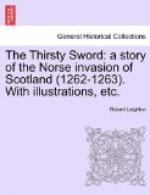Earl Hamish of Bute had but a few days before his tragic death been into Scotland to render account to Alexander the Third concerning his mission to the King of Norway. That mission had failed in its object. The letters of Henry of England and His Majesty of Scots had not succeeded in persuading the Norse monarch to resign his claims to the dominion of the Western Isles. King Hakon claimed that those lands, from the Lewis in the north even to the Isle of Man in the south, were his by right of both conquest and possession, and that each and all of the island kings, or jarls, were bound in fealty and vassalage to Norway. On the other hand, King Alexander claimed that he held yet stronger rights of sovereignty, and that the islands were even by nature intended to be part of Scotland.
The Western Isles, and more especially that group lying south of the holy island of Iona, were at this time in a most prosperous condition. Together with a large tract of country on the northeast of Ireland, they formed a sort of naval empire, with the open sea as its centre. They were densely populated. The useful arts were carried to a degree of perfection unsurpassed in other European countries. The learned Irish clergy had established their well-built monasteries over all the islands even before the arrival of the Norse colonists, and great numbers of Britons, flying hither as an asylum when their own country was ravaged by the Saxons, had carried with them the remains of science, manufactures, and wealth introduced by their Roman masters.
The habits of the islanders were piratical — the natural result of the possession of ships — and their conquests extended along the east of Ireland, the coast of Cumberland, and a large part of the mainland of Scotland, including the whole county of Caithness.
The Norwegian king, an ambitious and despotic monarch, who had risen to power from the position of a poor comb maker’s son, hoped by the help of these dependants to invade and conquer the whole of Scotland, and he was encouraged to the attempt by such self-seeking men as Roderic of Gigha and Erland of Jura, who made no scruple to enlist themselves in any cause that gave promise of increased power.
It was natural that the Scots kings, as they increased their strength, should wish to annex these districts. But the efforts of Somerled of Argyll in the twelfth century, and of King Alexander the Second in 1249, had done no more than secure the few islands lying within the shelter of the Firth of Clyde. Earl John of Islay and many of his neighbours were now paying homage to both Norway and Scotland. The isle of Gigha, which had been a possession of Alpin of Bute, had been bestowed at that chief’s death upon his younger son Roderic. But Roderic, as has been told, had gone over entirely to King Hakon, and had refused to acknowledge his vassalage to his rightful sovereign of Scotland.
Thus, at the time when young Kenric became the lord of Bate, the whole of the isles west of the peninsula of Kintyre were in the hands of petty kings, who, holding lands of both crowns, were still uncertain to whom they should pay their paramount allegiance.




